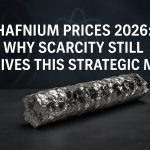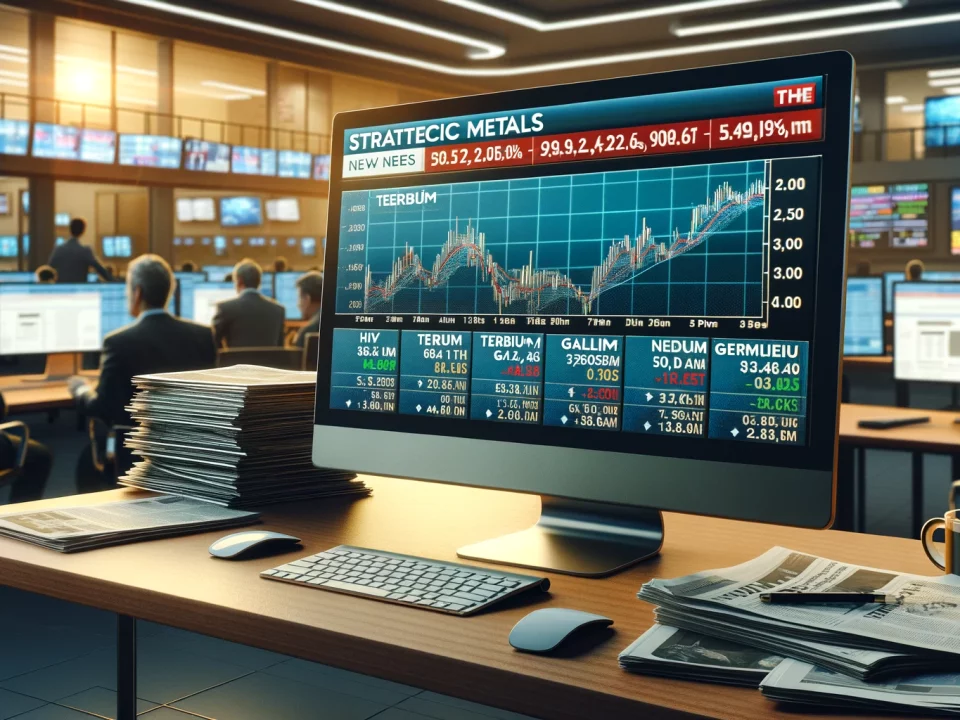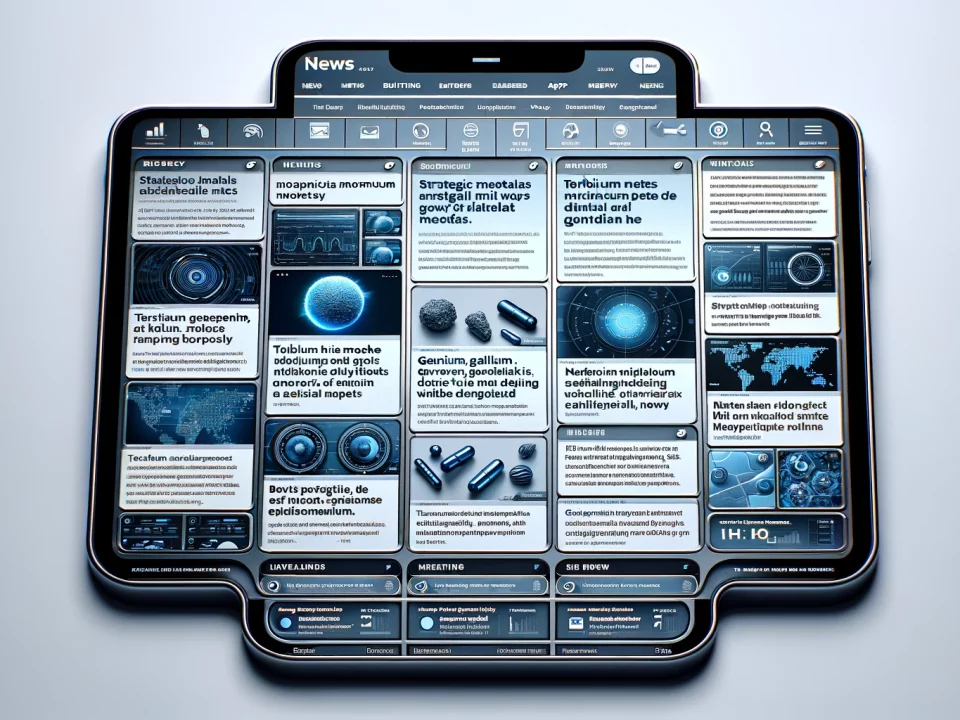
Hafnium Prices 2025: Why Scarcity Still Drives This Strategic Metal
September 16, 2025
Weekly News Review September 22 – September 28 2025
September 28, 2025Global activity in the critical minerals sector continues to accelerate, with the United States considering a $5 billion fund to support projects. In addition, the U.S. and Ukraine are partnering on a reconstruction fund to boost mineral development. Meanwhile, China is updating its dual-use export rules, streamlining licenses for goods with civilian and military applications.
All this and more from the newsroom at rawmaterials.net, our media partner on the industry side.
UNITED STATES: EXPORT-IMPORT BANK OF THE UNITED STATES EYES FUNDING FOR SCANDIUM PROJECT:
Australian critical minerals developer Sunrise Energy Metals has received a Letter of Interest (LOI) from the Export-Import Bank of the United States (EXIM) for up to US$67 million in potential funding for its Syerston Scandium Project in New South Wales. The proposed financing would cover roughly half of the project’s estimated development cost.
Just last week, Sunrise revised the project’s mineral estimate upwards, more than doubling the contained scandium inventory. The Syerston deposit is already considered the world’s largest and highest-grade scandium resource, according to the company.
The Scandium Market Has Been Tightening in Recent Months:
Global demand for scandium has tightened in recent months, particularly in North America, after China, the dominant global supplier, imposed export controls on scandium and six other rare earth elements in April 2025. These restrictions, along with Beijing’s broader bans on exports of critical minerals to the U.S. late last year, have intensified Washington’s push to diversify supply chains.
EXIM’s interest in Syerston aligns with a series of U.S. initiatives aimed at securing critical mineral supplies from allied nations. In January, the bank introduced a new financing tool for foreign mineral projects. Other government bodies, such as the Department of Defense and Department of Energy, have also ramped up efforts to strengthen domestic and allied supply chains of critical minerals.
GALLIUM COULD HELP DETECT DANGEROUS NANO-PLASTICS:
A new testing method aims to shed light on the largely unexplored risks nanoplastics pose to the environment and human health.
While the dangers of microplastics are widely recognized, their even smaller counterparts, nanoplastics, may represent an even greater threat. Measuring less than one micrometer (a millionth of a meter), these particles not only infiltrate ecosystems but also end up in food, drinking water, and even human organs, where they can persist and be passed on during cell division.
Nanoplastics are created when larger plastic items degrade under environmental influences such as sunlight, rain, or abrasion, but they can also arise from industrial processes and recycling.
Recent studies estimate that as much as 27 million tons of nanoplastics may already be present in the oceans. Yet, outside of highly specialized laboratories, there are currently few reliable methods to detect these particles. Now, researchers at the University of Melbourne in Australia and the University of Stuttgart in Germany have developed a technique designed precisely for this purpose. According to the team, it is cost-efficient and suitable for mobile use.
Optical Microscopy Makes Nanoparticles Visible Through Color Changes:
The researchers describe their invention as a test strip that functions like an optical sieve, composed of tiny cavities of varying sizes etched into gallium arsenide. When a liquid sample containing nanoplastics is poured over the strip, each particle becomes trapped in a cavity of corresponding size. To make the particles visible, the method exploits resonance effects inside the cavities.
Depending on their diameter and depth, these cavities interact with incoming light in ways that can be clearly detected under an optical microscope. When a nanoplastic particle drops into one of the cavities, the light pattern shifts, producing a distinct color change. This makes it possible to count the particles and determine their size.
Gallium arsenide was chosen for its high refractive index, the researchers report in Nature Photonics. Another advantage: the cavities can be fabricated using conventional semiconductor manufacturing techniques such as lithography, making the process simpler and faster than alternative methods.
The team has so far tested the approach with freshwater samples spiked with known concentrations of nanoplastics. In the future, the method could also be applied to blood and tissue analysis. Next, the researchers aim to investigate whether the technique can distinguish between different types of plastic. Their long-term goal is to bring the technology to market, helping scientists better understand the global impact of nanoplastic pollution on both the environment and human health.
MINING AND THE ENERGY TRANSITION: BRIDGING THE GAP WITH LOCAL COMMUNITIES:
S&P Global analysis reveals: Nearly half of all critical mineral mines are located on or near land used by Indigenous peoples or local communities. Protests are widespread in Latin America.
The energy transition will be nearly impossible without an expansion of global mining, industry experts consistently stress. Yet both new and existing mining projects often face strong resistance from local communities and environmental groups, even though the minerals extracted ultimately enable climate-friendly technologies such as wind turbines and electric vehicles.
Information provider S&P Global has analyzed these tensions and how mining companies are dealing with them, concluding that there is significant room for improvement in how affected communities are consulted and included.
One of the study’s key findings: 43 percent of mines producing minerals critical for the energy transition are located on, or adjacent to, officially recognized Indigenous territories or lands used by local communities. The data also show that adverse incidents, such as protests, are widespread in Latin America. More than three-quarters of the world’s lithium reserves are concentrated in Argentina, Bolivia, and Chile.
Mining in this so-called “Lithium Triangle” is often associated with heavy water consumption. In contrast, more positive examples, such as structured consultations, were reported from Australia and Canada, which the authors attribute to stricter and more consistently enforced protections for local populations.
Mining Industry Making efforts, but Progress Is Uneven:
Parts of the mining industry are already working to improve relations with local communities, but according to S&P Global, progress remains slow and inconsistent. Many companies still view communities primarily as a risk factor rather than as strategic partners. Smaller “junior mining companies” which typically handle exploration and early development phases often lack the financial and human resources for extensive engagement.
When larger companies later take over projects, they usually inherit whatever relationships already exist with the community. The level of protection also depends heavily on the strength and enforcement of local regulations.
With global demand for energy-transition minerals rising, S&P Global warns that the risk of conflict will also increase if communities are not adequately involved. Conversely, proactive and cooperative engagement can create benefits for both sides. The authors therefore recommend embedding meaningful participation, harm prevention, and risk mitigation along the entire mining value chain.
European Examples Highlight the Challenge:
Even in regions with relatively strict environmental regulations, aligning the interests of the mining and energy sectors with community concerns remains difficult. The European Union’s Critical Raw Materials Act (CRMA) requires that 10 percent of the EU’s demand for certain raw materials be met through domestic mining by 2030. But implementation is proving challenging.
For instance, the Matamulas project in northern Spain, one of Europe’s most promising rare earth deposits, is currently on hold due to environmental concerns. The Norra Kärr project in southern Sweden has advanced further, despite years of protests over potential threats to regional drinking water. Another Swedish rare earth deposit, Per Geijer, faces opposition as well, since its potential development could disrupt reindeer migration routes and thereby endanger the traditional way of life of the Indigenous Sámi people.
UNITED STATES CONSIDERS $5 BILLION STRATEGIC METALS FUND:
The U.S. is stepping up efforts to secure critical mineral supplies. According to Bloomberg, citing unnamed sources, the U.S. International Development Finance Corporation (DFC), in partnership with Orion Resource Partners, is discussing setting up a $5 billion fund to finance projects in the sector.
If realized, the fund would mark the latest direct intervention in critical mineral supply chains under the Trump administration. In March, President Trump signed an executive order aimed at boosting domestic production through streamlined permitting and expedited review processes.
Then, in July, the Pentagon announced a $400 million investment in MP Materials, the largest domestic rare earth producer, to become the company’s largest shareholder.
The push reflects Washington’s mounting concern over its heavy reliance on China for minerals deemed critical to national security and the energy transition. That dependence deepened in December, when Beijing banned exports of certain essential mineral products to the U.S., and again in April, when it expanded its export licensing requirements to cover additional materials.
The planned $5 billion initiative would complement other recent measures, such as the Department of Energy’s $1 billion commitment in August to strengthen U.S. critical mineral supply chains.
UNITED STATES AND UKRAINE PARTNER ON STRATEGIC METALS PROJECTS:
The U.S. International Development Finance Corporation (DFC), the U.S. government’s development bank, will provide $75 million in seed capital for a fund aimed at financing Ukraine’s reconstruction, according to a recent announcement. This initiative is part of a resource agreement between the U.S. and Ukraine, finalized in late April after prolonged negotiations.
Under the fund, Ukraine will contribute 50% of the revenues generated from future monetization of oil, gas, and other mineral resources, along with related infrastructure. However, the country will retain complete control over how these funds are used.
The U.S. hopes the agreement will strengthen its supply chains for critical raw materials and create investment opportunities in Ukraine. Ukraine will also provide $75 million to the fund, according to Prime Minister Yuliya Svyrydenko. The government aims to implement three major projects in energy, infrastructure, and critical minerals using the fund’s resources by the end of 2026.
CNINA UPDATES REGULATIONS ON DUAL USE STRATEGIC METALS:
China is streamlining its regulations for the export of so-called dual-use goods, products that have both civilian and military applications. These goods also contain a range of critical minerals, including heavy rare earths, tungsten, gallium, and germanium.
On Wednesday, the Chinese Ministry of Commerce (MOFCOM) published the revised regulations for public consultation, which will remain open for 30 days. The new framework replaces the previous rules, which had been in place since 2005, and introduces a more digital and streamlined licensing process. While most existing regulations remain intact, the amendments address certain loopholes and clarify enforcement measures.
Under the updated rules, licenses remain non-transferable, exporters are still required to retain all documentation for five years, and the permitted excess quantity cannot exceed 5% of the licensed amount. Key changes include the digitalization of licensing procedures and the formal designation of the Ministry of Commerce as the central authority overseeing export licenses.
The revisions also tighten controls on transshipments and re-exports. Previously prohibited in practice, these activities now explicitly require a license, including for goods merely transiting through China. Additionally, Beijing may now require supplementary end-use verification for sensitive items.
The updated regulations signal China’s effort to modernize export control procedures while maintaining robust oversight over strategic goods and critical minerals. A month ago, Beijing also updated its set of rules for the domestic rare earth sector, giving the government more control over the industry. As the world’s largest producer of critical commodities, the rare earth industry reflects China’s significant presence in the essential minerals sector.
EUROPE’S LARGEST RARE EARTH MAGNET PLANT OPENS IN ESTONIA:
Today, Friday, the largest rare earth magnet factory in Europe was officially inaugurated in Narva, northeastern Estonia. The Canadian company Neo Performance Materials runs the facility. Just a 30-minute drive away, in Sillamäe, Neo already operates a refinery for light rare earths; a second facility for heavy rare earths may follow.
For decades, both the processing of rare earths and the production of permanent magnets have been heavily concentrated in China. With the new Narva plant, Europe aims to strengthen its strategic autonomy and competitiveness significantly, according to the European Commission. The EU supported construction with €14.5 million from its Just Transition Fund, designed to facilitate the shift toward a climate-neutral economy. In addition, Canada’s export credit agency provided loans worth the equivalent of €45 million.
“This is the most important critical materials project happening in Europe today,” said Neo CEO Rahim Suleman in an interview ahead of the inauguration.
Neo first discussed the idea of building such a plant with the Estonian government in late 2021, as part of broader efforts to reduce Europe’s dependence on Chinese imports. The raw materials used will come in part from Brazil.
Meanwhile, German conglomerate Bosch has secured a share of the plant’s magnet production capacity. At the same time as the inauguration, Neo announced the signing of a multi-year memorandum of understanding with Bosch.
FIGURE OF THE WEEK: 135% – from aluminum to rare earths to vanadium, the demand for specialty raw materials in the US military sector will increase on average over the next ten years.
SOURCES: partners Tradium GmbH, rawmaterials.net, rohstoff.net
AUTHORS: Eric Hendrich, Isabella Mook, Brian Hendrich






